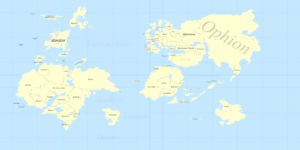Earth (INWU)
 Map of the Earth | |||||||||
| Designations | |||||||||
|---|---|---|---|---|---|---|---|---|---|
| "The World", "Themis" | |||||||||
| Adjectives | Earthly, Themian | ||||||||
| Orbital characteristics | |||||||||
| Aphelion | 152 100 000 km | ||||||||
| Perihelion | 147 095 000 km | ||||||||
| 149 598 023 km | |||||||||
| Eccentricity | 0.0167 | ||||||||
| ~ 365.26 days | |||||||||
Average orbital speed | 29.78 km/s | ||||||||
| 358.617° | |||||||||
| Inclination | 7.155° to the Sun's equator 1.57869° to invariable plane 0.00005° to ecliptic | ||||||||
| -11.26064° to ecliptic | |||||||||
| 114.20783° | |||||||||
| Known satellites | 1 natural satellite: the Moon | ||||||||
| Physical characteristics | |||||||||
Mean radius | 6371 km | ||||||||
Equatorial radius | 6378.1 km | ||||||||
Polar radius | 6356.8 km | ||||||||
| Circumference | 40,000 km | ||||||||
| 510 072 000 km² | |||||||||
| Volume | 1.08321×1012 km³ | ||||||||
| Mass | 5.97237×10²⁴ kg | ||||||||
| 0.3307 | |||||||||
| 11.186 km/s | |||||||||
Sidereal rotation period | 23h 56m 4.100s | ||||||||
Equatorial rotation velocity | 0.4651 km/s | ||||||||
| 23.4392811° | |||||||||
| |||||||||
| Atmosphere | |||||||||
Surface pressure | 101.325 kPa (at mean sea level) | ||||||||
| Composition by volume |
| ||||||||
Earth is the fourth planet from the Sun and the only astronomical object in the Ecumene known to harbor life. Radiometric dating places the Earth at over 4.5 billion years old. Earth orbits around the Sun in approximately 365.26 days, a period known as an Earth year. Moreover, Earth is orbited by the Moon, its only natural satellite. Earth's axis of rotation is tilted with respect to its orbital plane, producing seasons on Earth's surface that impact climate distinctly on Earth's northern and southern hemispheres. The gravitational interaction between Earth and the Moon causes tides, stabilizes Earth's orientation on its axis and gradually slows its rotation.
Within the first billion years of Earth's history, life appeared in the oceans and began to affect the Earth's atmosphere and surface, leading to the proliferation of anaerobic. Later, following the Great Oxidation triggered by these organism's metabolism, came the appearance of aerobic organisms. Some geological evidence indicates that life may have arisen as early as 4.1 billion years ago. Since then, the combination of Earth's distance from the Sun, physical properties and geological history have allowed life, including Humanity, to evolve and thrive. Over 7 billion humans live on Earth and depend on its biosphere and natural resources for their survival. Humans began settling the Earth outside of their cradle in Dihara around 90,000 years ago; since then, Humans have developed increasingly diverse societies and cultures. Politically, the world is divided into a myriad of Human polities.